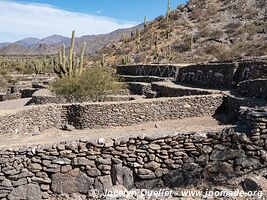Ruinas de los Quilmes
The ruins of Quilmes, also called the Sacred City of the Quilmes, is located at the foot of the Cerro Alto del Rey some 60 kilometres south of Cafayate. The site protects the remnants of dwellings, two cemeteries, animal enclosures, and lofts for grain.
Helped by archeological research, historians have concluded that the city was inhabited from the 11th century. A theory claims the Quilmes came from Chile and they migrated to Argentina fleeing the advance of the Inca Empire. The inhabitants lived of agriculture and livestock farming; they grew potatoes, beans, corn, and quinoa while the farming of llamas provided meat, milk, and wool.
The Quilmes have resisted the Spanish Conquistadors for more than 130 years. It is only in 1667 that they were defeated; the Spanish came to Argentina at the beginning of the 1500s. The surviving Quilmes were deported to the province of Buenos Aires and to other cities. A few survivors were able to evade the Spanish and nowadays, they are part of the Quilmes community. It is only from 2008 that the Quilmes descendants manage the site and offer services to the visitors.
The museum
A great evening with the Banda Loca
At the beginning of my trip to Argentina, I met the couple Silvina and Christian; two travellers with a campervan. Then, as time passed, we met a few times and we also met other travellers. I created a WhatsApp group to share photos and I named it la Banda Loca (the band of crazies). The name stuck and the people from the group still meet when it is possible. I have seen some of the members a few times during my visit of northern Argentina and I hope to see them again after my trip to Bolivia.
At the ruins of Quilmes, I met the group again and we spent a very enjoyable evening in camping near the entrance of the site. We made a fire and we shared an excellent meal.
The next day, I wanted to cross the mountains using a trail visible on the GPS. When the path started to climb in the mountain, I only drove a few kilometres since it was becoming rougher very quickly. I still had to do some 30 kilometres and climb more than 1500 metres before reaching the opposite side; thus I wasn't going to risk such a road.
I turned back and I headed toward Cafayate and the Quebrada de las Conchas.

















































